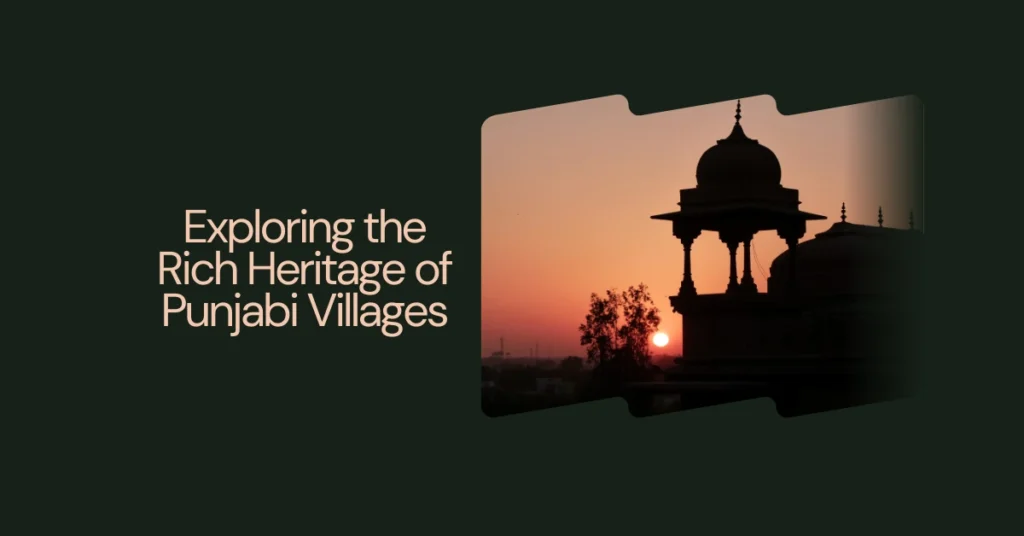
Introduction
The villages of Punjab are a testament to a rich and vibrant heritage, where time-honoured traditions have continued through generations. The soul of Punjab thrives in these villages, where agriculture, family ties, and deep-rooted customs create a unique lifestyle. This article will take you on a journey through the traditions, lifestyle, and cultural evolution of Punjabi villages, exploring the heart of Punjab.
The Landscape of Punjabi Villages
Set against a backdrop of lush green fields and winding rivers, Punjabi villages are deeply influenced by their landscape. The fertile land along the rivers has made Punjab an agricultural powerhouse. The geography has shaped the lifestyle, with open fields and vast stretches of farmland creating a serene and simple atmosphere.
Historical Roots of Punjabi Villages
Punjabi villages are steeped in ancient history, with ties to the Indus Valley Civilization. Sikhism, which originated in Punjab, plays a crucial role in shaping village life. Local folklore, religious practices, and oral traditions have been passed down through generations, adding depth to the cultural roots of these communities.
Village Architecture and Layout
Traditional Punjabi homes often feature large courtyards, flat roofs, and mud-brick walls, designed to withstand both hot summers and cold winters. These houses are built with a communal mindset, emphasizing family and togetherness. Central points in villages, like the Gurdwara (Sikh temple) and the village well, serve as gathering spots for social interaction, fostering a close-knit community.
The Role of Agriculture in Punjabi Villages
Agriculture is the backbone of Punjabi village life, with most families relying on farming for their livelihood. Key crops include wheat, rice, sugarcane, and mustard, harvested with traditional methods. Agriculture not only supports families financially but also fosters a deep connection to the land, instilling a sense of pride in rural communities.
Punjabi Folk Music and Dance
Music and dance are integral to Punjabi culture, with traditional forms like Bhangra and Giddha showcasing the vibrancy of village life. Bhangra, originally a harvest dance, has become symbolic of Punjabi pride and is often performed at festivals and celebrations. These art forms are more than entertainment; they’re a celebration of life, joy, and cultural identity.
Festivals and Celebrations
Punjabi villages come alive during festivals, each with unique customs and traditions. Baisakhi, marking the harvest season, is celebrated with music, dance, and communal feasting. Lohri celebrates the end of winter with bonfires and folk songs, while Maghi honors warriors and religious history. Each festival reflects the agricultural cycle and emphasizes unity and gratitude.
Traditional Attire of Punjabi Villagers
The traditional attire in Punjabi villages is both colorful and functional. Men often wear kurta-pajamas or lungis, while women don salwar-kameez with vibrant dupatta (scarves). The colors and patterns of these clothes are reflective of the local culture and the simplicity of village life.
Cuisine of Punjabi Villages
Punjabi cuisine is a highlight of village life, featuring dishes like makki di roti (corn flatbread) and sarson da saag (mustard greens). Meals are often prepared with fresh produce straight from the fields. The food is hearty, flavorful, and served with love, embodying the spirit of hospitality that Punjabi villagers are known for.
Family and Social Structure
The joint family system is central to Punjabi villages, where multiple generations live under one roof, sharing responsibilities and resources. Elders hold a respected position, guiding the family with wisdom and tradition. This social structure fosters a sense of belonging and continuity, with each family member playing a specific role.
Artisan Crafts and Skills
Punjabi villages are known for their artisanal skills, including Phulkari embroidery and pottery. These crafts are passed down through generations, each piece telling a story of tradition and creativity. Craftsmanship in Punjabi villages is more than a skill; it’s a heritage, with each item holding cultural significance.
Education and Modernization
Education in Punjabi villages has evolved over the years, with a growing emphasis on literacy and skill development. While traditional values remain strong, younger generations are seeking modern education to improve their lives. This balance between modernization and tradition presents both opportunities and challenges for village life.
Punjabi Village Life: Then vs. Now
Village life in Punjab has seen changes due to urbanization, migration, and technological advances. While modern conveniences are slowly being introduced, many families strive to retain traditional values. This blend of old and new defines contemporary Punjabi villages, where technology meets tradition in unique ways.
Challenges Facing Punjabi Villages Today
Punjabi villages face challenges such as climate change, economic shifts, and youth migration to cities. These factors impact agricultural production and threaten to erode traditional lifestyles. However, community efforts and government programs aim to address these issues, preserving the heritage of rural Punjab.
Conclusion
Punjabi villages represent a unique blend of history, culture, and tradition, standing as a testament to the enduring spirit of rural Punjab. Preserving this heritage is essential to maintaining the cultural identity of Punjab. In a world of rapid change, the villages of Punjab offer a glimpse into a life rooted in simplicity, community, and connection to the land.
FAQs: Rich Heritage of Punjabi Villages
What are Punjabi villages known for?
Punjabi villages are celebrated for their rich culture, traditional agriculture, warm hospitality, and deep-rooted customs that reflect the essence of Punjab.
How do Punjabi festivals reflect village life?
Festivals like Vaisakhi and Lohri highlight the agricultural cycle and emphasize community, gratitude, and joy, central to the village way of life.
Why is agriculture central to Punjabi culture?
Agriculture has been the backbone of Punjab’s economy and way of life, connecting people to the land and providing sustenance for generations.
How has modernization affected Punjabi villages?
Modernization brings new opportunities and challenges to Punjabi villages, influencing education, family structures, and lifestyle while sparking efforts to preserve traditional values.
What efforts are being made to preserve this heritage?
Local and government initiatives aim to sustain Punjabi village traditions through programs supporting agriculture, crafts, and cultural preservation.


